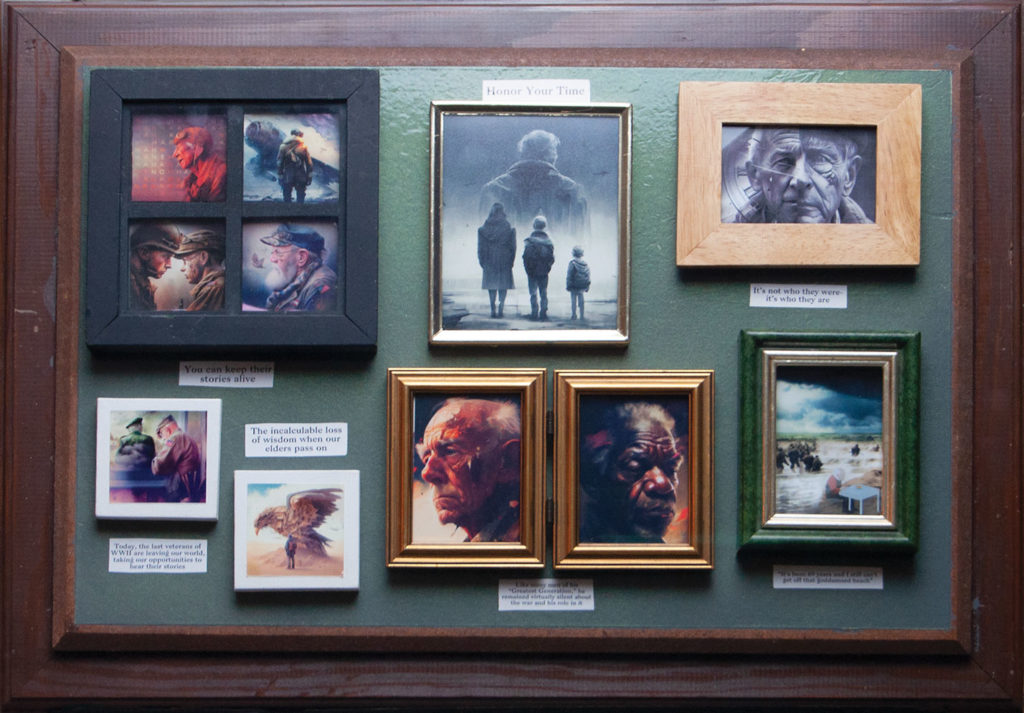
Jeff Elmore
21″ x 15″ • Mixed Media
Artist Statement
Honor Your Time is a multimedia collage composed of wood, paint, paper, metal, glass, plastic, text, images, and concepts encoded by trillions of numbers stored in silicon wafers and magnetic fields. Starting from a reading of Michael’s text, AI art tools MidJourney V4 and Stable Diffusion 2.1 were directed to generate images using a series of text prompts including excerpts from the text plus words and phrases capturing the artist’s reactions to the text. Algorithms translate the words and phrases in the prompts into locations in a conceptual space of ideas, emotions, light, objects, cultural and historic events, and artistic styles and techniques that guide the composition of the image. The resulting images, meticulously curated, convey themes of service, loss, pain, duty, and the precious and fleeting quality of living memory. Their display in a collage of thrifted frames– an intersection of people, objects, stories, words, and trillions of numbers jostled about just so; all conspiring to meet you today at the end of this sentence.
Instagram: @enzondio
by Michael Calabrese
Who we meet in life is largely a matter of when we are born. I’m one of the last baby boomers (no great distinction) born in 1955 and I’m a civilian (also no great distinction). When I was ten years old, just about every man I knew over the age of 40 had served in World War II, family members, teachers, men who lived in my apartment building. One uncle was a B-17 pilot with the 8th Air Force; another was an Ack-Ack gunner on a destroyer in the Pacific. A teacher came ashore in Normandy on D-Day with the 29th Infantry and a camp counselor was in the first wave with the 1st Infantry. I looked upon all of them as heroes.
My wife’s father really was a hero with the 6th Infantry in the Pacific, two Silver Stars, four Bronze Stars, three Purple Hearts, and multiple Oak Leaf Clusters (including one attached to a Purple Heart). He died more than 50 years ago – an indirect effect of his wounds. Like many men of his “Greatest Generation,” he remained virtually silent about the war and his role in it. Then an unexpected 200 men showed up at his funeral.
Today, the last veterans of WWII are leaving our world, taking our opportunities to hear their stories with them. I was fortunate enough to have met one much more recently. My mother died in 2014. She had Alzheimer’s and was living in a nursing home with a good mind care facility. There I met her friend Warren on June 6th, 2013.
Warren was a nice shrunken little man who sat hunched over his vanilla pudding, which he ate twice a day – every day. One spoonful followed the last as he hurried to finish his bowl muttering that he had to get done quickly so he could “pick up Allison.” His wife had been dead for ten years. That didn’t matter, of course. It was his job in life to pick up Allison.
Among the most disturbing things about dementia aren’t the times when suffers wander around lost in their own minds. It’s when they suddenly focus on the world around them with a desperate moment of clarity. It was the anniversary of D-Day and the movie “The Longest Day” was on the TV in their dining room when an aide passed by and, knowing that Warren was a veteran, asked if he wanted her to turn up the sound.
“That’s alright, honey,” Warren replied. “I don’t need a movie. I was there. Yup! 131st!” While he’d never even spoken to me directly, he locked his eyes on mine and said, “It’s been 69 years, and I can’t get off of that Goddamned beach!” Then the internal switch got thrown, his eyes lost focus and another spoon of vanilla pudding went into his mouth…
We look a people like Warren and see unsteady legs, a walker or a wheelchair, yellowed skin or trembling hands and we wonder at who they were in life. That’s wrong. It’s not who they were – it’s who they are. We’d better never forget it. We owe it to them, to ourselves, and to the next Greatest Generation.
